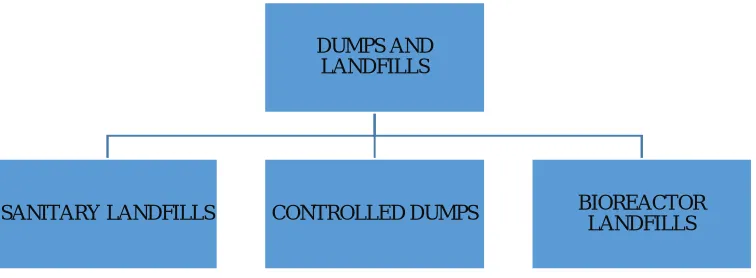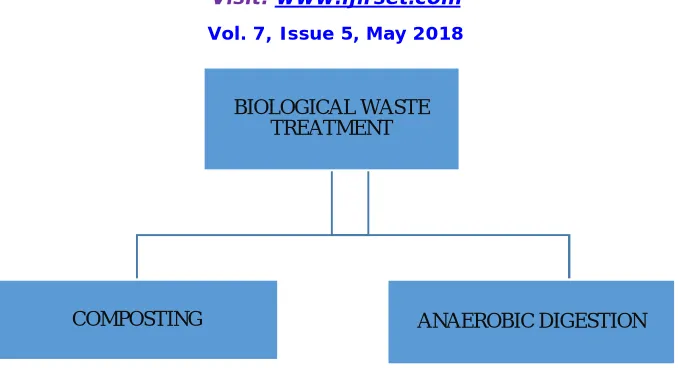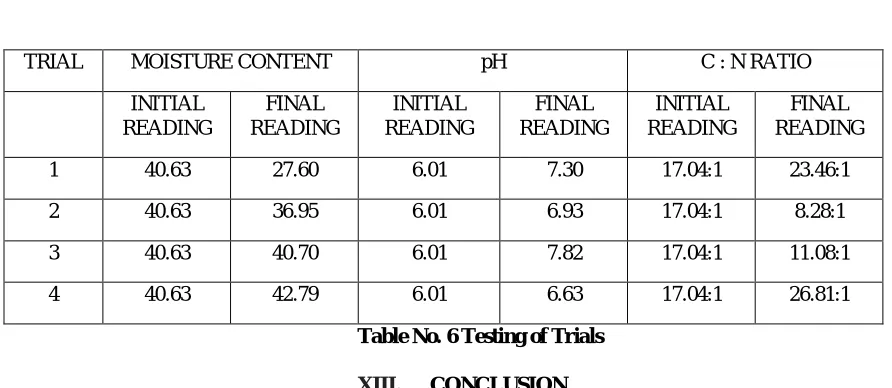Design of Vermicomposting Pits at Optimum
Conditions for Organic Waste Management
Madhuri Gokulkar1, Mrunalini Patil2
U.G. Student, Department of Civil Engineering, SITS, Narhe, Pune, Maharashtra, India1
Assistant Professor, Department of Civil Engineering, SITS, Narhe, Pune, Maharashtra, India2
ABSTRACT :Over the period of time the problem of disposal of solid waste is increasing with the urbanisation and industrialization. Many methods are derived to treat organic solid waste but the most effective method is vermicomposting. Traditional methods like thermal treatments and landfilling methods provide instant result but it creates adverse effects on surrounding environment. Vermicomposting is an efficient way where organic waste is decomposed naturally by using earthworms. This method overcomes the ill effects of the traditional methods and also it is widely practiced these days. In this paper, two types of earthworms are used to treat the waste along with whey powder which acts a culture for the earthworms and various parameters affecting the vermicomposting method are considered for obtaining maximum efficiency.
KEYWORDS : Earthworms,Efficiency, Organic Solid Waste, Vermicomposting.
I. INTRODUCTION
Organic waste can be treated by thermal treatments, landfilling methods, biological and chemical methods. In thermal treatment, there are three methods namely incineration, pyrolysis and gasification and open burning. Incineration involves the combustion of organic substances. In pyrolysis, oxygen is not used to decompose organic waste by exposing it to high temperatures. Gasification decomposes organic waste by exposing it to high temperatures and uses a low oxygen environment. Open burning is the burning of waste materials causes smoke and releases other harmful gases in the environment.
Sanitary landfills, controlled dumps and bioreactor landfills are classified as methods of dumps and landfills. Sanitary Landfills are designed for waste disposal which may pose to the public health and environmental quality. Bioreactor landfills use enhanced microbiological processes to accelerate the decomposition of waste.
In biological waste treatment, composting and anaerobic digestion are two main methods. Composting is the decomposition of organic matter by the action of micro-organisms. Composting techniques are vessel composting, windrow composting, vermicomposting and static pile composting. Anaerobic digestion is the process in which decomposition of organic waste in the absence of oxygen.
Table No. 1 Thermal Treatment
In the above table, classification of thermal treatment is provided which includes incineration, pyrolysis and gasification and open burning. Incineration is the combustion of organic waste materials by burning. Pyrolysis and gasification is the thermal decomposition of waste in the absence and presence of oxygen. Open burning is the burning of waste in an open space.
Table No. 2 Sanitary Landfill Methods
In the above table, dumps and landfills are classified as sanitary landfills, controlled dumps and bioreactor landfills. Sanitary landfilling is the dumping of waste on a site away from the city. Controlled dumping is a method of waste disposal with no environmental control. Bioreactor landfills is a method to rapidly transform and degrade waste.
THERMAL TREATMENT
INCINERATION PYROLYSIS &
GASIFICATION OPEN BURNING
DUMPS AND LANDFILLS
SANITARY LANDFILLS CONTROLLED DUMPS BIOREACTOR
Table No. 3 Biological Treatment
In the above table, biological treatment is classified as composting and anaerobic digestion. Composting is a process in which organic waste is decomposed naturally with the help of earthworms. Anaerobic digestion is a method in which micro-organisms break down organic material in the absence of oxygen.
II. PUBLISHED RESEARCH
This section presents review on design of vermicomposting pits at optimum conditions for organic waste management. Vermicomposition is natural method to treat the organic waste by using earthworms and micro organisms. Earthworms play a significant role in the decomposition process as they act as mechanical blenders and they tend to modify its properties such C:N ratio, surface area exposed and their physical and chemical status. The organic matter with the help of earthworms are converted into material which is similar to humus and it can be used for plant growth as a fertilizer. This process is explained in detail by Jorge Dominguez and his team member in Vermicomposting Organic Wastes.[12]
In a paper “The preparation and use of compost”, Madeleine Inckel and his team members have explained the composting process and stated various reasons to adopt this method over other treatment methods. They have mentioned about the properties of composting such as improvement of soil, improvement of soil resistance, retainment of nutrients and many more such properties and also they have discussed the importance of nutrients such as Nitrogen (N), Phosphate (P) and Potassium (K).[6]
In a paper “Environmental factors affecting vermicomposting of municipal solid waste” by G. Amaravathi and his partner have considered the parameters which affect the composting process. The factors that have been taken into consideration are temperature, pH, moisture content, electrical conductivity and C:N ratio. In this research work, two types of earthworms are used; viz, one from the indigenous category and the other from exotic species category. The characteristics and effects of each parameter with these two types of earthworms on composting are discussed in detailed.[7]
III. OBJECTIVES
BIOLOGICAL WASTE TREATMENT
IV. PROBLEM STATEMENT
To reduce the time consumed by this process.
To increase the efficiency at optimum conditions.
V. FACTORS AFFECTING VERMICOMPOSTING
Carbon-to-Nitrogen Ratios:Carbon can be considered the food and nitrogen the digestive enzymes.
pH : pH is required for earthworms to survive. It is unsuitable for worms if it is too acidic or too alkaline. pH value should be between 6.0 and 8.0.
Moisture : Microorganisms require aeration for survival and proper functioning and so the compost pile should have a moisture content of 40-60 percent.
VI. METHODOLOGY
TRIAL 1 – Eudrilus Eugeniae are used in pit no. 1
In this trial, 1 kg of Eudrilus Eugeniae are used to decompose 5 kg of organic waste. The pits are of size 3ft X 3ft X 3ft and it consists of three layers of dry plant materials, layer of moist (green) plant materials including food leftovers and layer of animal manure. The pit is covered with jute bag and water is sprinkled over it. It is then covered with dry leaves and kept away from sunlight.
TRIAL 2 – Eisenia Fetida are used in pit no. 2
In this trial, 1 kg of Eisenia Fetida are used to decompose 5 kg of organic waste. The pits are of size 3ft X 3ft X 3ft and it consists of three layers of dry plant materials, layer of moist (green) plant materials including food leftovers and layer of animal manure. The pit is covered with jute bag and water is sprinkled over it. It is then covered with dry leaves and kept away from sunlight.
TRIAL 3 – Eudrilus Eugeniae + Culture used in pit no. 3
In this trial, 1 kg of Eudrilus Eugeniae are used to decompose 5 kg of organic waste. The pits are of size 3ft X 3ft X 3ft and it consists of three layers of dry plant materials, layer of moist (green) plant materials including food leftovers and layer of animal manure. Whey powder is thoroughly mixed with water and sprinkled over the layers as it rapidly multiplies the earthworms and increases the efficiency of composting. The pit is covered with jute bag and water is sprinkled over it. It is then covered with dry leaves and kept away from sunlight.
TRIAL 4 – Eisenia Fetida + Culture used in pit no. 4
TRIAL NO. TRIAL
1 Eudrilus Eugeniae used. 2 Eisenia Fetida used. 3 Eudrilus Eugeniae + Culture used. 4 Eisenia Fetida + Culture used.
Table No. 4 Trials
VII. DESIGNING OF REACTORS
Compost pit size – 3ft X 3ft X 3ft.
Volume of one pit = 0.764555 m3
Quantity of waste disposed in one pit =5 kg per pit
Type of waste – Organic Solid Waste
Area of one pit = 0.557418 m2
No pits required = 4
Duration – 30 days
Types of Earthworms used – Eisenia Fetida and Eudrilus Eugeniae
Earthworms released = 1kg per pit.
VIII. COLLECTION AND SAMPLING OF WASTE
In this thesis, organic solid waste is collected from Bhoomi Green Energy, Unit II, RDF Plant. In each pit, 5 kg of organic waste is used and 1 kg of earthworms of two different types are used for decomposition of this waste.
IX. PROCUREMENT OF EARTHWORMS
Type I :Eudrilus Eugeniae
These earthworms are native to tropical west Africa and are used for vermicomposting in warm regions. In this thesis, 1 kg of Eudrilus Eugeniae is used in trial pit 1 for decomposting 5 kg of organic solid waste. These earthworms are also used in trial pit 3 along with the culture to decompose the waste.
Type II :Eisenia Fetida
X. USING WHEY POWDER AS CULTURE
Whey powder is a bi-product obtained from milk products and has high content of proteins and caseine. In this thesis, it is used as culture as it rapidly multiplies the growth of earthworms and increases the rate of decomposition.
XI. IDEAL RANGE OF PARAMETERS
PARAMETERS IDEAL RANGE
MOISTURE CONTENT 40-50
pH 6.5-8.5
C : N RATIO Less than 27
Table No. 5 Ideal Range of Parameters
XII. RESULTS
TESTING OF TRIALS
TRIAL MOISTURE CONTENT pH C : N RATIO
INITIAL READING
FINAL READING
INITIAL READING
FINAL READING
INITIAL READING
FINAL READING
1 40.63 27.60 6.01 7.30 17.04:1 23.46:1
2 40.63 36.95 6.01 6.93 17.04:1 8.28:1
3 40.63 40.70 6.01 7.82 17.04:1 11.08:1
4 40.63 42.79 6.01 6.63 17.04:1 26.81:1
Table No. 6 Testing of Trials
XIII. CONCLUSION
The moisture content does not vary with the addition of whey powder for both earthworms and is in within permissible limits.
The pH of organic waste for all the four trials is in within the permissible limits.
It is observedthat when whey powder is added to Type1 earthworms, C:N ratio decreases which implies that metabolic activity of the Type 1 earthworms has increased and the rate of decomposition has also increased. This indicates that the good quality of end product is obtained as compared to the pit which does not consist of whey powder.
rate of decomposition has decreased. This indicates that good quality of end product is obtained for the pit without whey powder.
In trial 2 and 3, the quality of compost obtained after testing is excellent as compared to the other two trials.
REFERENCES
1. Bhide, A. D. and Sudershan, Solid Waste Management in Developing Countries, Indian National Scientific Documentation Centre, New Delhi, 1983. 2. Lauber, J. D.
2. Nagavallemma KP, Wani SP, StephaneLacroix, Padmaja VV, Vineela C, BabuRao M and Sahrawat KL, “Vermicomposting: Recycling Wastes into Valuable Organic Fertilizer”, 2004.
3. POOJA NIDONIa1 AND POOJA MATHbab, “SOLID WASTE MANAGEMENT BY VERMICOMPOSTING PROCESS”, Bagalkot, India. 4. Saleh Ali Tweib ,RakmiAbdRahman and MohdSahaidKalil, “Composting”.
5. Madeleine Inckel, Peter de Smet, Tim Tersmette , Tom Veldkamp, “The preparation and use of compost”.
6. G.Amaravathi&R.Mallikarjuna Reddy, “Environmental factors affecting vermicomposting of municipal solid waste”
7. Stefan Shilev, MladenNaydenov, VentsislavaVancheva,and Anna Aladjadjiyan, “Composting of Foodand Agricultural Wastes”. 8. R.V. Misra and R. N. Roy FAO, “ON-FARM COMPOSTING METHODS”, Rome.


